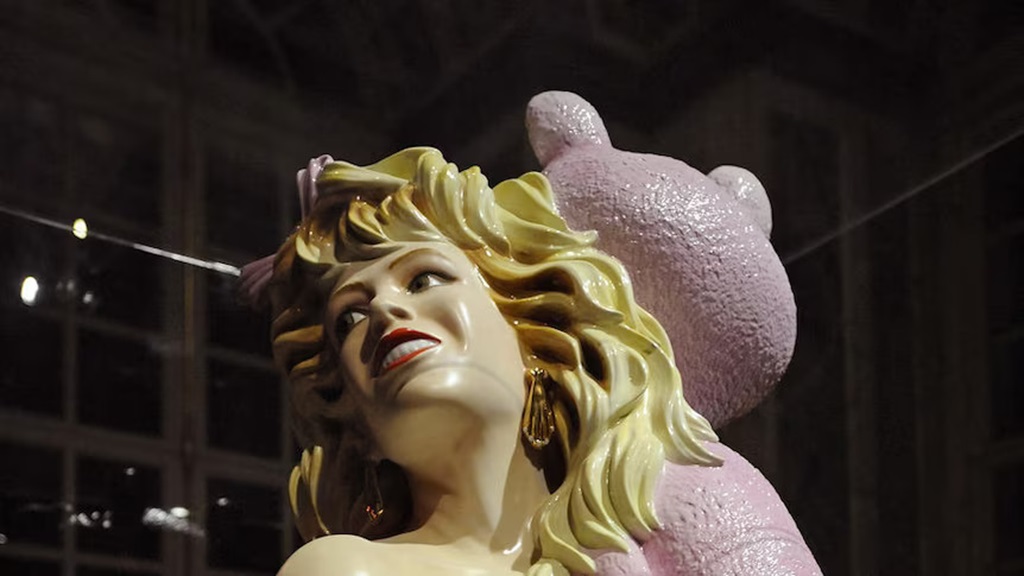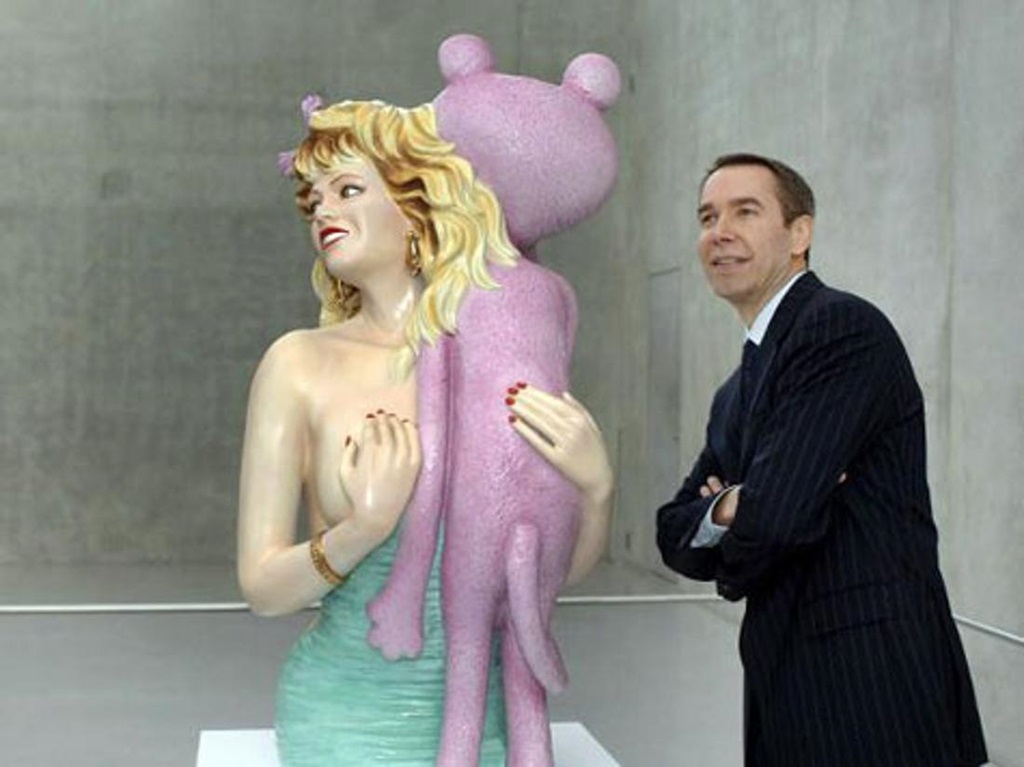Jeff Koons’ “Pink Panther” is a captivating sculpture that often leaves viewers with more questions than answers. Who is this woman with a dazzling smile and audacious attire? What does she represent? Why is she paired with the iconic cartoon feline?
The woman in Pink Panther Jeff Koons is Jayne Mansfield, a Hollywood bombshell from the 1950s and 1960s. Known for her platinum blonde hair, hourglass figure, and unabashed sexuality, Mansfield was a symbol of both desire and kitsch within American pop culture.
Why Jayne Mansfield?
Koons didn’t just randomly choose Jayne Mansfield for his sculpture. Her persona and legacy tie directly into the themes he explores in his infamous “Banality” series (of which “Pink Panther” is a part):
- Kitsch and Consumerism: Mansfield rose to fame during an era of post-war prosperity and booming consumerism. Koons utilizes her image to examine the seduction of mass-produced objects and pictures and our desire to possess them.
- Fame and Celebrity Culture: Mansfield was a master of self-promotion, understanding the power of image. Koons references this by presenting her in a staged pose, as if permanently ready for the flash of paparazzi cameras.
- Sexuality and Desire: Mansfield’s blatant sensuality was both celebrated and criticized. Koons plays with this tension, inviting viewers to consider the nature of desire and societal expectations of female sexuality.
Understanding Pink Panther Jeff Koons
Sculpted from brightly colored porcelain, “Pink Panther” captures a seemingly playful interaction between Mansfield and the cartoon character. The Pink Panther rests limply in her hand, its face nuzzled against her shoulder.
This juxtaposition is critical to understanding the work:
- High vs. Low Culture: Koons blurs the lines between “high art” and popular culture. Jayne Mansfield represents mass-produced entertainment, while the Pink Panther is a cartoon icon of childhood. Koons forces the viewer to question these distinctions by elevating them into fine art.
- Control and Vulnerability: Is the woman lovingly clutching the Pink Panther, or is it a trophy? Is the cat helplessly dependent or subtly subversive? Koons leaves it up to the viewer to decide who holds power in this dynamic.
The “Banality” Series
“Pink Panther” was a significant piece in Koons’ controversial “Banality” series, exhibited in 1988. This collection of sculptures aimed to confront viewers with exaggerated symbols of cultural excess, sentimentality, and superficiality.
Think of the “Banality” series as looking into a funhouse mirror. It reflects society at us but distorts it, forcing us to look closely at our values and judgments. Other “Banality” works include sculptures of Michael Jackson with his pet chimp Bubbles and kitschy porcelain figurines like Hummel collectibles.
Why Do We Care About “Pink Panther”?
Jeff Koons is one of the most polarizing figures in contemporary art. Some dismiss his work as shallow and commercially driven, while others applaud his ability to provoke conversation about consumerism, taste, and society.
“Pink Panther” is no exception. Here’s why it continues to fascinate us:
- It Challenges Convention: Traditional fine art is often serious and sad. “Pink Panther” embraces the gaudy, the kitsch, the things we’re often told are “in poor taste.” It makes us question those standards.
- It Reflects Our World: We live in a society obsessed with celebrity, saturated with images. “Pink Panther” holds a mirror to this reality, exaggerating it in a way that’s both disturbing and darkly humorous.
- It Invites Interpretation: There’s no single “right” answer to what “Pink Panther” means. The sculpture invites individual viewers to project their ideas about desire, fame, and societal values onto it.
“Pink Panther” Through History
It’s fascinating to note how perceptions of “Pink Panther,” and Koons’ work in general, have shifted over time:
- Initial Shock and Outrage: When the “Banality” series debuted, many critics considered it a cynical attack on taste and artistic integrity. Koons was heavily criticized for what was perceived as a commercially driven approach to art.
- Gradual Acceptance: Art historians began to reassess Koons’ work. They acknowledged his ability to reflect contemporary culture and force us to examine our values. “Pink Panther” is now recognized as an iconic piece of Pop Art.
- Commercial Success: Koons is one of the most commercially successful living artists. His works, including “Pink Panther,” command astronomical prices at auction. This raises interesting questions about the relationship between art and the market.
The Legacy of Jayne Mansfield and Koons’ Depiction
Jayne Mansfield’s tragic death in a car accident at the age of 34 solidified her reputation as a tragic blonde bombshell. However, it’s important to remember she was also a savvy businesswoman who understood the power of image creation.
Koons’ portrayal of Mansfield raises complex questions:
- Celebration or Exploitation? Does Koons celebrate Mansfield’s self-determined sexuality, or does he exploit her image for shock value? There is no easy answer, and it sparks much-needed conversation.
- Frozen in Time: Koons freezes Mansfield in a moment of perpetual stardom. This raises questions about our obsession with celebrity, our desire to immortalize figures beyond their natural lives, and how images shape our perceptions.
Beyond the Surface of “Pink Panther”
While “Pink Panther” is instantly recognizable for its eye-catching color and overt subject matter, there’s much more to uncover:
- Technical Skill: Koons’ work, for all its conceptual underpinnings, is also incredibly well-crafted. The porcelain figures are meticulously detailed, their surfaces flawlessly smooth. This tension between the abstract and the technical is part of what makes his work so compelling.
- Humor and Irony: There’s a dark humor in “Pink Panther.” The juxtaposition of the cartoon cat with the overtly sexualized woman is jarring. Koons uses this irony to poke fun at our cultural obsessions and the absurdity of mass-produced sentimentality.
Is It Art? The Ongoing Debate about Jeff Koons
Ultimately, the debate about whether Jeff Koons’ work and “Pink Panther” is “good art” will likely never end. And that’s the point! Koons forces us to consider what art is, who decides what has value, and why we react so strongly to specific images and objects.
Conclusion
Pink Panther Jeff Koons is more than just a sculpture of a woman and cartoon cat. It mirrors our cultural obsession with celebrity, desire, and mass-produced objects. Whether you love or hate it, “Pink Panther” refuses to be ignored and continues to provoke conversation about art, culture, and our values.
FAQs
Who created “Pink Panther”?
Jeff Koons is a contemporary American artist known for exploring consumerism, pop culture, and taste.
What is “Pink Panther” made of?
It’s a porcelain sculpture, brightly colored and approximately 40 inches tall.
Is the woman depicted as a natural person?
Yes, the woman is Jayne Mansfield, a Hollywood sex symbol from the 1950s and 1960s.
Why is “Pink Panther” controversial?
Koons’ work often challenges traditional notions of “good art.” It forces us to confront our values and the line between high and low culture.
Where can I see “Pink Panther”?
There are a few versions of “Pink Panther”. One is owned by the Museum of Modern Art (MoMA) in New York City. Others are held in private collections and occasionally come up for auction.






